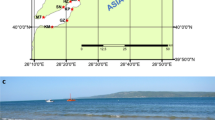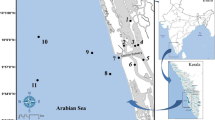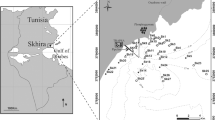Abstract
Composition, densities and biomass of sublittoral macrozoobenthos were investigated at 14 sites in the enclosed Rhine-Meuse Delta. The aim was to identify the main macrozoobenthic assemblages and to establish their relationship with environmental conditions, including sediment pollution. Most sites were dominated by the tubificidsLimnodrilus hoffmeisteri andL. claparedeanus. Four zoobenthic assemblages could be identified. They are related to different geomorphological phases of a basin filling up with fluvial sediment causing a longitudinal sediment gradient. The ’Rhine river’ assemblage was found in the Nieuwe Merwede, filled up in the 1970's, the ’soft mud’ assemblage in the Hollands Diep at sites with high sedimentation rates; the ’basin silt’ assemblage in the Amer, Hollands Diep and Haringvliet, at sites with lower sedimentation rates, and the ’basin shoal’ assemblage at former flats with low sedimentation rates. CANOCO was used to relate the TWINSPAN indicator species to a selection of environmental parameters. Sediment pH, water content, sand fraction, total polycyclic aromatic hydrocarbons (PAH) and current velocity explained 44% of the variance of the average abundance of the indicator taxa per site. Sediment firmness, indicated by sediment water content, and high ammonium concentrations probably were together responsible for the very low densities in the ’soft mud’ assemblage. Densities and biomasses in the other assemblages were low as well, except for theDreissena polymorpha habitat, where very high total zoobenthic biomass values (max. 55.8 g m−2) were observed. It is argued that sediment contamination has a considerable impact on macrozoobenthic densities and species composition in all assemblages, the ’basin shoal’ assemblage excepted.
Similar content being viewed by others
References
ADMIRAAL, W. and B. VAN ZANTEN, 1988. Impact of biological activity on detritus transport in the lower River Rhine: an exercise in ecosystem analysis. Freshwater Biol., 20: 215–225.
ANONYMOUS, 1993. Biological typology of freshwater sediments. Normal values for biological parameters. Under the authority of Rijkswaterstaat, Riza and others. Report 92.0241 of Aquasense, Amsterdam (in Dutch).
APHA, 1985. Standard methods for the examination of water and waste water. Am. Publ. Health Assn., Washington, 16th ed.
BENKE, A.C., 1984. Secondary production of aquatic insects. p. 289–322. In: V.H. Resh and D.M. Rosenberg, Eds., The ecology of aquatic insects.
BONGERS, T. and J. VAN DE HAAR, 1990. On the potential of basing an ecological typology of aquatic sediments on the nematode fauna: an example from the River Rhine. Hydrobiol. Bull., 24: 37–45.
BORCHERDING, J. and E.D. DE RUYTER VAN STEVENINCK, 1992. Abundance and growth ofDreissena polymorpha larvae in the water column of the River Rhine during downstream transportation, In: D. Neumann and H.A. Jenner, Eds., The Zebra mussel,Dreissena polymorpha: ecology, biological monitoring and first applications in the water quality management, (Fischer Verlag, Stuttgart). Limnologie aktuell, 4: 29–44.
BIJ DE VAATE, A., A. KLINK and F. OOSTERBROEK, 1992. The mayfly,Ephoron virgo (Olivier), back in the Dutch parts of the Rivers Rhine and Meuse. Hydrobiol. Bull., 25: 237–240.
DE JONG, S.A., P.A.G. HOFMAN and A.J.J. SANDEE, 1988. Gradients of physico-chemical and biological parameters in the Rhine bottom. Delta Institute for Hydrobiological Research, Yerseke, The Netherlands, Internal Report (in Dutch).
DE KOCK, W. CHR. and C.T. BOWMER, 1992. Bioaccumulation, biological effects, and food chain transfer of contaminants in the Zebra mussel (Dreissena polymorpha) In: T.F. Nalepa and D. Schloesser, Eds., Zebra mussels: biology, impacts, and control. p. 503–533, CRC Press. Florida.
DEN BESTEN, P.J., 1993. Biotic effects caused by sediment pollution in the delta of the Rivers Rhine and Meuse (The Netherlands) Part I: Nieuwe Merwede. Rijkswaterstaat, RIZA, Lelystad, Report 93.020 (in Dutch).
DEN HARTOG, C., 1963. The amphipods of the deltaic region of the rivers Rhine, Meuse and Scheldt in relation to the hydrography of the area. I. Introduction and hydrography. Neth. J. Sea Res., 2: 29–39.
DIRKSEN, S., T.J. BOUDEWIJN, L.K. SLAGER, R.G. MES, M.J.M. SCHAIK and P. DE VOOGT, 1995. Reduced breeding success of Cormorants (Phalacrocorax carbo sinensis) in relation to persistent organochlorine pollution of aquatic habitats in the Netherlands. Environ. Poll., 88: 119–132.
DUDOK VAN HEEL, H.C., H. SMIT and S.M. WIERSMA, 1992. Densities, biomass and species composition of macrozoobenthos in the Lower Rhine-Meuse (The Netherlands), Rijkswaterstaat, RIZA, Leystad. Publications and reports of the project ’Ecological rehabilitation of the Rivers Rhine and Meuse’ no. 39; RIZA report 91.051 (in Dutch with English summary).
DUDOK VAN HEEL, H.C., J.A. VAN DER VELDEN and S.M. WIERSMA, 1993. Development of macrozoobenthos in transplanted sediments in the Northern Delta area. Rijkswaterstaat, RIZA, Lelystad. Report 93.022.
FERGUSON, H.A. and W.J. WOLFF, 1983. The Haringvliet-project: The development of the Rhine-Meuse estuary from tidal inlet to stagnant freshwater lake. Wat. Sci. Technol., 16: 11–26.
FORTUIN, A.W., 1985. Densities and biomass of the most important bottom fauna of the Hollandsch Diep and Haringvliet in 1983. Delta Institute for Hydrobiological Research, Yerseke, Report 1985-2 (in Dutch).
GALES, M.E., E.C. JULIAN and R.C. KRONER, 1966. Method for quantitative determination of total phosphorus in water. J. Am. Water Works Ass. 58: 1363–1368.
GRIFFITHS, R., 1992. Effects of zebra mussels (Dreissena polymorpha) on the benthic fauna of Lake St. Clair. In: T.F. Nalepa and D. Schloesser, Eds., Zebra mussels: biology, impacts, and control, p. 415–437. CRC Press, Florida.
HENDRIKS, A.J. and H. PIETERS, 1993. Monitoring concentrations of microcontaminants in aquatic organisms in the Rhine Delta: a comparison with reference values. Chemosphere, 26: 817–836.
HILL, M.O., 1979. TWINSPAN — A FORTRAN program for arranging multivariate data in an ordered two-way table by classification of individuals and attributes. Cornell University, Ithaca, New York, 90 p.
IZVEKOVA, E.I. and A.A. L'OVA-KATCHANOVA, 1972. Sedimentation of suspended matter byDreissena polymorpha Pallas and its subsequent utilization by Chironomidae larvae. Pol. Arch. Hydrobiol., 19: 203–210.
JOHNSON, M.G., O.C. McNEIL and S.E. GEORGE, 1987. Benthic macroinvertebrate associations in relation to environmental factors in Georgian Bay. J. Great Lakes Res., 13: 310–327.
JONGMAN, R.H., C.J.F. TER BRAAK and O.F.R. VAN TONGEREN, 1987. Data analysis in community and landscape ecology. Pudoc, Wageningen.
KLINK, A.G. and H.C. DUDOK VAN HEEL, 1993. Macro-invertebrates on the bottom of the Hollandsch Diep-Haringvliet. Rijkswaterstaat, RIZA, Lelystad. Publications and reports of the project ’Ecological rehabilitation of the Rivers Rhine and Meuse’ no. 48 (in Dutch).
LAFONT, M., 1984. Oligochaete communities as biological descriptors of pollution in the fine sediments of rivers. Hydrobiologia, 115: 127–129.
LAFONT, M., 1985. Oligochaetes and pollution in the sediments of rivers: an improved index of biological quality. Report of CEMAGREF, Lyon, France.
LANG, C. and B. LANG-DOBLER, 1979. The chemical environment of tubificid and lumbriculid worms according to the pollution level of the sediment. Hydrobiologia, 65: 273–282.
LEUVEN, R.S.E.W., T.C.M. BROCK and H.A.M. VAN DRUTEN, 1985. Effects of preservation on dry- and ash-free dry weight biomass of some common aquatic macro-invertebrates. Hydrobiologia, 127: 151–159.
MARQUENIE, J.P. and G. HOORNSMAN, 1986. Biological inventory in October and November 1985 of the Rhine and Haringvliet. TNO Delft, report R. 86/60, (in Dutch).
MARQUENIE, J.P., P. ROELE and G. HOORNSMAN, 1986. Research into the effects of contaminants on diving ducks. TNO Delft, report 86/066 (in Dutch).
Ministry Of Transport And Public Works, 1989. Water in the Netherlands: a time for action. Summary of the Third National Water Policy Document, The Hague, The Netherlands.
MOSS, B. and M. TIMMS, 1989. Predation, sediment stability and food availability as determinants of the benthic invertebrate fauna in two shallow lakes. Hydrobiologia, 185: 249–257.
MURK, A.J., A. SPENKELINK, A. BROUWER, M VAN KAMPEN, A.T.C. BOSVELD, J. GRADENER, and M. VANDEN BERG, M., 1993. Effects of PCBs, PCDDs and PCDFs on reproductive success, and morphological, physiological and biochemical parameters in chicks of the Common tern (Sterna hirundo). Rijkswaterstaat, Tidal Waters Division, The Hague, The Netherlands, Report 93.001.
REYNOLDSON, T. B., 1987. Interactions between sediment contaminants and benthic organisms. Hydrobiologia, 149: 53–66.
ROBBINS, J. A., T. KEILTY, D. S. WHITE and D. N. EDGINGTON, 1989. Relationships among tubificid abundance, sediment composition and accumulation rates in Lake Erie. Can. J. Fish. Aquat. Sci., 46: 223–231.
SMIT H. and H. C. DUDOK VAN HEEL, 1992. Methodical aspects of a simple allometric biomass determination ofDreissena polymorpha (Pallas) aggregations, In: D. Neumann and H.A. Jenner, Eds. The Zebra mussel,Dreissena polymorpha: ecology. biological monitoring and first applications in the water quality management, (Fischer Verlag, Stuttgart), Limnologie aktuell, 4: 79–86.
SMIT, H., A. BIJ DE VAATE, H.H. REEDERS, E.H. VAN NES and R. NOORDHUIS, 1992a. Colonization, ecology. and positive aspects of Zebra mussels (Dreissena polymorpha) in The Netherlands. In: T.F. Nalepa and D. Schloesser, Eds., Zebra mussels: biology, impacts, and control, p. 55–77, CRC Press, Florida.
SMIT, H., E. DUDOK VAN HEEL and S. M. WIERSMA, 1992b. Biovolume as a tool in biomass determination of Oligochaeta and Chironomidae. Freshwat. Biol., 29: 37–46.
SMIT, H., F. HEINIS, R. BIJKERK and F. KERKUM, 1993.Lipiniella arenicola (Chironomidae) compared withChironomus muratensis andCh. nudiventris: distribution patterns related to depth and sediment characteristics, diet and behavioural response to reduced oxygen concentrations. Neth. J. Aquat. Ecol., 26: 431–440.
SMIT, H., J.A. VAN DER VELDEN and A.G. KLINK, 1994. Macrozoobenthic assemblages in littoral sediments in the enclosed Rhine-Meuse Delta area. Neth. J. Aquat. Ecol., 28: 199–212.
SOSTER, F.M. and P.L. McCALL, 1990. Benthos response to disturbance in Western Lake Erie: field experiments. Can. J. Fish. Aquat. Sci., 47: 1970–1985.
STELLING, G.S., A.K. WIERSMA and J.B.T.M. WILLEMSE, 1986. Practical aspects of accurate tidal computations. J. Hydr. Engrg., 112: 802–817.
TEN HULSCHER, Th.E.M., L.E. VAN DER VELDE and W.A. BRUGGEMAN, 1992. Temperature dependence of Henri's law constants for selected chlorobenzenes, polychlorinated biphenyls and polycyclic aromatic hydrocarbons. Env. Tox. Chem., 11: 1595–1603.
TER BRAAK, C.J.F., 1987. Unimodal models to relate species to environment. Groep Landbouwwiskunde, Wageningen, 152 pp.
TER BRAAK, C.J.F., 1991. CANOCO — a FORTRAN program for canonical community ordination (partial) (detrended) (canonical) Correspondence Analysis, Principal Components Analysis and Redundancy Analysis (version 3.1). TNO Institute of applied computer science, Wageningen.
VAN BERGHEM, J.W., M.A. DAMOISEAUX and P.F. VAN DREUMEL, 1992. Geomorphological mapping of the Haringvliet, Hollandsch Diep, Nieuwe Merwede and Amer. Report and 6 maps. Rijkswaterstaat, Zuid Holland Directorate, Rotterdam (in Dutch).
VAN HATTUM, B., I. BURGERS and B. VAN DER HORST, 1993. Heavy metals in chironomids, oligochaetes and sediments from the Northern Delta area. Report E-93/03 of the Institute for Environmental studies, Free University, Amsterdam. Under authority of the Institute of Inland Water Management and Wastewater Treatment (in Dutch).
VAN NES, E. H. and H. SMIT, 1993. Multivariate analysis of macrozoobenthos in Lake Volkerak-Zoommeer (The Netherlands): changes in an estuary before and after closure. Arch. Hydrobiol., 127: 185–203.
VAN OTTERLOO, R., J.W. Van Berghem, J.W.M. Kuijpers, A. Broekhuizen, P.F. Van Dreumel and J. Mol, 1987. The water bottom of the Northern Delta area. Report Rijkswaterstaat, Directie Benedenrivieren, 29 pp. (in Dutch).
VAN URK, G., F.C.M. KERKUM and S.M. WIERSMA, 1985. Benthic fauna in polluted sediments. H2O, 18: 509–513 (in Dutch).
VAN URK, G., F.C.M. KERKUM and H. SMIT, 1992. Life cycle patterns, density and frequency of deformities inChironomus larvae (Diptera: Chironomidae) over a contaminated sediment gradient. Can. J. Fish. Aquat. Sci., 49: 2291–2299.
VAN URK, G., F.C.M. KERKUM and C.J. VAN LEEUWEN, 1993. Insects and insecticides in the lower Rhine. Water Research, 27: 205–213.
VERDONSCHOT, P.F.M., 1981. Some notes on the ecology of aquatic oligochaetes in the Delta Region of the Netherlands. Arch. Hydrobiol., 92: 53–70.
VEN TE CHOW, 1959. Open-channel hydraulics. McGraw-Hill book company, New York, 680 p.
VIERVEYZER, H.C., A. LEPELAAR and J. DIJKSTRA, 1979. Analysis methods for soil, sewage sludge, crops and liquids. Report of the Instituut voor Bodemvruchtbaarheid, Groningen, The Netherlands (in Dutch).
WARWICK, W. F., 1991. Indexing deformities in ligulae and antennae ofProcladius larvae (Diptera: Chironomidae): application to contaminant-stressed environments. Can. J. Fish. Aquat. Sci., 48: 1151–1166.
WARWICK, W. F. and N. A. TISDALE, 1988. Morphological deformities inChironomus, Cryptochironomus andProcladius larvae (Diptera: Chironomidae) from two differentially stressed sites in Tobin Lake, Saskatchewan. Can. J. Fish. Aquat. Sci., 45: 1123–1144.
WIEDERHOLM, T., A.M. WIEDERHOLM and G. MILBRINK, 1987. Bulk sediment bioassays with five species of fresh-water oligochaetes. Water, Air and Soil Pollution, 36: 131–154.
WILLIAMS, K.A., D.W.J. GREEN and D. PASCOE, 1986. Studies on the acute toxicity of pollutants to freshwater macroinvertebrates. 3. Ammonia. Arch. Hydrobiol., 106: 61–70
WOLFF, W.J., 1973. The estuary as an habitat. An analysis of data on the soft-bottom macrofauna of the estuarine area of the rivers Rhine, Meuse and Scheldt. Rijksmuseum van Natuurlijke Historie, Leiden, Zoölogische Verhandelingen, 126: 3–242.
Author information
Authors and Affiliations
Rights and permissions
About this article
Cite this article
Smit, H., Reinhold-Dudok Van Heel, H.C. & Wiersma, S.M. Sublittoral macrozoobenthic assemblages in the enclosed sediment-polluted Rhine-Meuse Delta; their relationship to environmental conditions. Netherlands Journal of Aquatic Ecology 29, 31–47 (1995). https://doi.org/10.1007/BF02061787
Issue Date:
DOI: https://doi.org/10.1007/BF02061787




